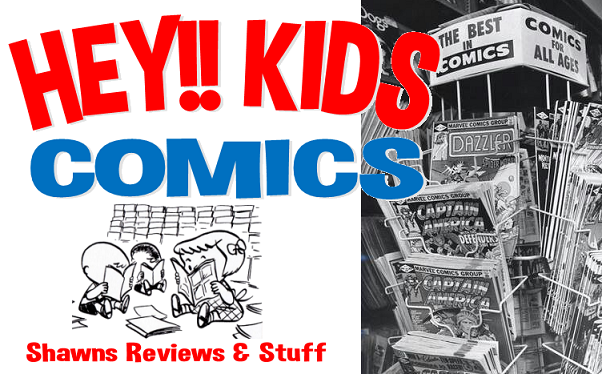Hey Kids! Comics!, the sign practically screamed. Oddly, the tin sign on top of the spinner rack was far less colorful than the pages of the comics it displayed, and those colors were mostly made up of your brain lying to you about many tiny dots. For the young collector of the 1970’s, it was always disturbing how rickety those racks were, how unfortunate it was to have that rust touching such potential treasure. It was a lawless time when Fine shape meant the book hadn’t been fanned through by a horde of other nerds marauding with Slurpee-coated hands, trying to see all of the books in any given pocket by pulling them earthward as fast as they could until the contents of each pocket looked like lines of drunks asleep on ropes in a Victorian city.
Clearly, the act of selling comic magazines has changed somewhat. It even sounds different. Take a Little Golden Book spinner rack, for instance. When that thing whirls around, it sounds like Robocop pulling a gun out of his leg. Long gone the squealing you could hear from across the White Hen.
 Yet one thing has remained constant, one thing sold from of those angry wire condition-destroyers is still sold off of the wall of today, the reprint. You see tykes, the reprint comes from an era when you just didn’t have access to all things all the time. Television programs happened once and were gone forever, unless it was popular enough to warrant a rerun. This logic applied to the funny books as well, but in what probably won’t surprise you, in a mostly random fashion.
Yet one thing has remained constant, one thing sold from of those angry wire condition-destroyers is still sold off of the wall of today, the reprint. You see tykes, the reprint comes from an era when you just didn’t have access to all things all the time. Television programs happened once and were gone forever, unless it was popular enough to warrant a rerun. This logic applied to the funny books as well, but in what probably won’t surprise you, in a mostly random fashion.
In those days, the Big Two were basically the Only Two. Marvel had 3 titles that were publishing comic runs in numerical order (an impressive feat then, as they had no computers and Marvel can barley publish books in order today), Marvel Tales, Marvel’s Greatest Comics, and Marvel Triple Action. There were also various Collector’s Item Classics and whatever got shoved into any annuals as well. Most of these fine pamphlets had “new” covers, which frequently consisted of old illustrations that were cut and pasted, with literal scissors and actual paste, just like Pot Pete used to use.
 DC was on board as well, with Secret Origins giving you 3 heroes’ first appearances in each issue, and Wanted doing the same for the bad guys. The DC 100 Page Super Spectaculars were even more random in what they reprinted, to the degree that one can only assume the choosing of them involved Dick Giordano blindfolding an intern, pointing him in the direction of a bunch of old filing cabinets, and yelling “Mush!” For the kids, a filing cabinet was where we used to keep stuff before it all fit in our pockets. You know, stuff like old comic book art boards, because nobody would ever want those.
DC was on board as well, with Secret Origins giving you 3 heroes’ first appearances in each issue, and Wanted doing the same for the bad guys. The DC 100 Page Super Spectaculars were even more random in what they reprinted, to the degree that one can only assume the choosing of them involved Dick Giordano blindfolding an intern, pointing him in the direction of a bunch of old filing cabinets, and yelling “Mush!” For the kids, a filing cabinet was where we used to keep stuff before it all fit in our pockets. You know, stuff like old comic book art boards, because nobody would ever want those.
As everything old is new again, both the Big Two and now maaany mooore publishers have embraced the loving reproduction of eternal works of art, or as we call it, “Flooding the racks” That’s right kids, like Ed Wood trying to make a whole movie out of whatever stock footage was lying about, we shall never be bereft of more of stuff from before.
The first time I ever heard the term “Flooding the racks” was 1983. Most reprint material prior to that tended to be at least 5-10 years old. In a brave new world filled with Baxter and Mando trees, that window shrank faster than that of the latest Guy Ritchie film. The books reprinted on the newest shiny paper tended to be considered more high-quality work. Fun fact! When editors read the words “high quality” they actually see the words, “virtually free.” Yes sir! In America, we sell things more than once, because we tend to forget things more than twice. When P.T. Barnum got those marks to go look at the “Egress”, he knew that they’d pay to get back in, lest they miss a single thing.
Oh, you scamps! FOMO isn’t new, abbreviating it is.
The best of the reprints were the Treasury Editions. They were the same size as the ones that DC has been doing recently, that size being the dimensions of an old Apple monitor. Lemme tell ‘ya, in the days before video games, nothing could beat a comic book the size of your own head.
DC even had its treasury size 1st Edition Special line. They were exact reprints of the most important first appearances the publisher had ever printed! Exact! Exactly like what we now call a facsimile edition, only 5 times larger and 4 dollars cheaper. I suppose that’s just what happens when you transition into a niche hobby from ” Shut up kid. Here’s a quarter. Go find a comic while Mommy gets some Tab.”
There is a fiscal Yin to the unfortunate Big Two Yang (which is also the name of my Kpop/Chicago Blues fusion duo) however, and that is called the Image Firsts line. Image, a company built from two Middle Phanlanx bones on up, seems to want new people to read their books. At least I think that’s the plan, because they are only a dollar. Like the countless copies of Future’s End specials that litter our cheapest back issue boxes, but good. For a dollar, they’re brilliant. While it is unfortunate that they are not cranium-sized, they are excellent at pointing out the Big Two’s clothes are not only old, they cost as much as brand new ones.
So, like all things, no matter if they’re a reprint, facsimile, or counterfeit Cerebus #1, there are the good ones and great ones. There’s also a facsimile edition of All-New Marvel Now! Point One #0001. Because there’s always a Yang. Sometimes he even has a house, as in House of Yang from Charlton comics, which debuted in 1975…
…and was reprinted in Modern Comics #1 in 1978.


